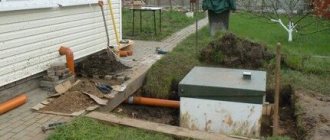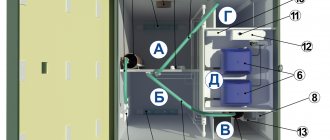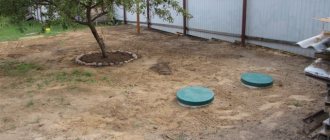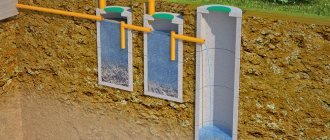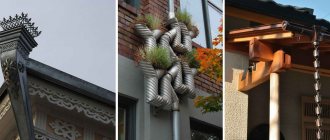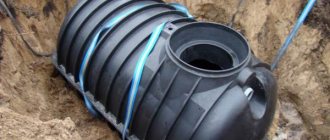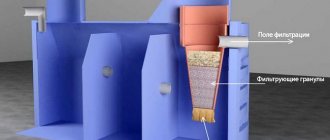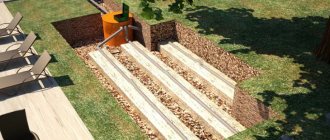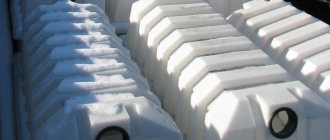Arrangement of an autonomous sewer system in a country house is one of the most important for the owner of a cottage or other territory. In order for wastewater to be treated correctly, it is necessary to solve the problem by installing an optimal set of structures. Topas is an ideal option for many people because of its functionality, practicality and uniqueness.
This treatment facility is a septic tank that operates on a station basis. In this material we will consider not only its main functions, but also independent installation on your site, as well as further maintenance. This type of equipment has a large number of advantages that set it apart from competitive facilities and treatment plants.
How does a biotreatment system work?
Septic tank "Topas" is a unique system for biochemical wastewater treatment on private territory. The main backbone that allows it to function concerns anaerobic and aerobic bacteria. If we consider the chemical side of the issue, the process is as follows - the installation oxidizes wastewater with oxygen, which is artificially pumped into the system.
This effect on wastewater does real miracles. They are almost completely purified and can be easily disposed of in the ground, filtration fields, and so on. Such wastewater is already safe and will not harm nature or living organisms. Special, positive microorganisms destroy the organic component of wastewater and make it much cleaner. Such waters do not rot and look almost transparent.
Use and care
After launch, the septic tank must operate continuously for a month with a nominal number of users. Time to return to normal mode is 30 days. After this time, the outlet water should appear clean and odorless.
During the first period of operation, about thirty days, silt forms. This process is accompanied by foaming, sometimes abundant. The main reason why foam is formed is the use in households of various synthetic substances that make up household liquids.
Preparing for winter does not require much trouble: the septic tank is equipped with a lid that has good thermal insulation. If the external temperature is not less than minus 20 degrees and the influx of household wastewater is at least 20%, the septic tank does not require any specific winter preventive measures. With the onset of severe frosts, the upper part of the septic tank is additionally insulated. When additionally insulating the lid, it is necessary to ensure air flow through the ventilation air intake. If the temperature is below minus 15 degrees, you should not open the septic tank lid unnecessarily.
To preserve for the winter or other long period, it is necessary to perform a certain sequence of actions.
- Flush the installation.
- Chamber by chamber, pump out the contents of the septic tank and fill each chamber with clean water (no more than 40% of the volume of each) in the sequence: sludge stabilizer settling chamber – aeration tank chamber – receiving chamber. And so on until the water is completely clarified. After filling the septic tank, the level of clean water should be 180 cm from the bottom of the septic tank.
- Clean pumps, airlifts and nozzles.
- Disconnect the septic tank from the power supply.
- Remove the compressors from the compressor compartment. In forced septic tanks, remove the pump.
- Insulate the septic tank lid in winter.
How often do you need to treat water using a septic tank?
The specialists who created this cleaning system developed a generally accepted plan and standards. They fully comply with all environmental safety standards. The wastewater becomes 98% cleaner, which is a unique result. Simple microorganisms are able to process organic matter into a safe element - it sounds fantastic, but it’s true and it really works.
It is worth installing a septic tank if you need to maintain a cottage with permanent residence in it. Operation should be performed at least three times a week, no less. This is what all created standards say. The key condition for the operation of the entire system is a constant supply of water. When bacteria do not receive food for themselves, they simply die and, as a result, the system becomes ineffective.
The main structure of the treatment plant consists of four compartments. All of them are combined into one whole system. Cleaning processes are carried out in each. That is, wastewater will go through four stages before it can become purified. The advantage of the design is that all the compartments are located in a compact case, which makes it practical and easy to install.
Let's take a closer look at the operation of each compartment:
- First compartment. Responsible for accepting incoming wastewater directly from the sewer. Here they stand. The system works on a special principle - all heavy parts must settle to the bottom. Anaerobes begin their main functions in the form of processing and oxidizing all particles. A special float switch emits special signals for the compressor, which pumps liquid to the next compartment.
- Second compartment. Experts call it an aeration tank, in other words, a rectangular tank. There are also a large number of aerobic bacteria that constantly eat and process organic compounds. But unlike the previous compartment, a large amount of oxygen is pumped into this one. It is needed so that the breakdown of organic matter is final. It also provides oxygen to aerobes for their vital functions.
- Third compartment. This is the second settling tank. The functions are almost the same as the first compartment. There is a special element here called the “calming pyramid”. There is a large amount of biomass inside. It constantly processes wastewater and separates water.
- Fourth compartment. The last of all to perform the final function. This is where water separation occurs due to aerobes. They create activated sludge, which is waste from life. The water goes through several stages of purification and leaves the compartment using a special hole. The sludge steadily flows to the bottom of this compartment; it must be removed from time to time. Often the procedure needs to be carried out at least once a year, depending on the frequency of use of the septic tank.
Features of the purifier, the subtleties of its operation and maintenance with your own hands
The principle of operation of a septic tank assumes that microorganisms will constantly receive raw materials for their vital functions. Therefore, Topas must be operated without long breaks. This means that its installation is optimal for homes where people stay permanently (or regularly come there on weekends).
Next point. Microorganisms are not able to eat and decompose all the waste that residents of city apartments have the habit of flushing down the toilet. To ensure the normal functioning of bacteria, you must take care of their proper nutrition. It's easy to do. Do not pour the following substances into the Topas septic tank:
- rotting vegetable and fruit products, as they can cause the death of microorganisms;
- acid and chlorine containing compounds;
- technical fluids and oils;
- medicines and alkaline compounds.
Also, the operating principle of the purification structure prohibits the discharge into it of various objects and elements that are insoluble by their nature. These include plastic films and bags, household and technical waste, waste construction materials. Such objects can clog compressor units and purifier compartments and damage the entire structure. And bacteria do not feed on inorganic compounds.
Operating principle of the cleaning structure
The Topas system is available in different variations. Various septic tank models are designed for a certain volume of wastewater in one day. Exceeding the recommended amount of waste is strictly prohibited! You need to choose the model that suits your case.
But from an operational and technical point of view, all septic tanks under the Topas brand are the same. We have already examined the principle of their operation, and now we will highlight the unique characteristics of such units:
- no noise during operation;
- compact dimensions;
- high efficiency of wastewater decomposition;
- absence of unpleasant odors due to the complete sealing of the installation;
- automated septic tank operation;
- minimal electricity consumption.
Let's look at the steps in more detail
The first stage is a simple biological fermentation, which is started by microorganisms living inside the compartment. The main decomposition of contaminants occurs in the second section, or more precisely, on the walls of the container. A special coarse filter is installed at the entrance to this compartment. It catches clots, hair and dirt that has not settled at the bottom and continues its “journey” throughout the entire section.
Naturally, such water cannot be drunk. But it receives sufficient cleaning to water the plants in the local area. The plantings will grow and bloom to the fullest. This is a big plus because you save a large amount on water use. Water can flow from the third section to the fourth in two ways. This is gravity flow or the purchase of a special pump that will carry out the pumping process.
The drainage pump and float alarm are not installed in all models of the Topas septic tank; it all depends on the wishes of the buyer. That is, pumping out wastewater can be natural or forced. Which option is better? The second one is more functional and faster, but it is not always relevant for some users. It all depends on the frequency of use of the septic tank, whether you need to pump water quickly or not.
Why are compressors needed?
Many potential buyers are wondering what the compressors do inside this system. Everything is very simple, there must be oxygen inside the containers at all times. After all, the main processes of natural decomposition of organic masses are impossible without the presence of this element. It is necessary to provide microorganisms with oxygen, because they are also living beings. Only then can they be viable and effective.
Continuous flows of oxygen and a dose of activated sludge are a guarantee of constant and high-quality oxidation of organic elements. This is the basis for the operation of this septic tank. Where to get oxygen from? This is where compressors are needed. A pair of such units are installed in a special bunker. They constantly saturate the liquid with oxygen and create optimal conditions for the life of bacteria and their functioning.
That is, without compressors, the operation of the entire septic tank would be impossible. If such a part fails, the treatment plant becomes useless. Bacteria simply cannot live in such conditions, and optimal microflora will not be created. Compressors constantly activate the circulation of wastewater in the chambers and mix the contents with activated sludge. In other words, it is a natural filter; it constantly combines various particles with each other.
What are the advantages and disadvantages of the Topas septic tank?
The main advantage of the system is that each stage is completely safe. The treatment plant does not pollute the environment. No fumes or other nuisances that could affect people or surrounding areas. This applies to all processes, each of them is completely safe. The advantages of the system at this stage do not end, but only begin:
- The Topas septic tank is an almost ideal option in terms of the resulting percentage of purity of purified water. Waste liquid is an unsafe mass that can affect not only human health, but also the surrounding areas. It rots, stinks and decays. The septic tank is capable of purifying any wastewater by 98%, which allows it to be reused. A unique result obtained through a biological process rather than chemistry.
- The treatment plant consumes virtually no electricity compared to other analogues. Compensators and other components inside the structure do not require much “power”. The septic tank can be used constantly and this will have virtually no impact on your costs.
- No noise. The problem with various water treatment plants is a large number of annoying sounds. It could be a grinding sound, the sounds of flowing water, or just a measured rumbling sound, as if starting a car. The Topas septic tank is almost silent. Especially if it is installed away from living rooms on private property. In this case, you will not even know about its existence until you come close.
- The treatment plant is easy to maintain, that's a fact. Even a child can clean it of activated sludge and other components. It's a very simple process. It is simple thanks to the design of the septic tank; everything is done so that cleaning is quick and as efficient as possible. And you don’t need to do it too often.
- Practicality and small dimensions allow you to place a septic tank even in a small area. Unlike similar treatment plants, it can fit almost anywhere.
- The integrity of the structure is also a huge plus. There are four compartments inside, but they all combine into one. This makes the septic tank a single structure, allowing it to be moved and reinstalled, if necessary.
But Topas also has tangible shortcomings that every potential buyer should know. There is nothing ideal in this world, such technology is no exception. Let's look at the disadvantages of this cleaning system:
- The entire system is dependent on a constant and continuous supply of electricity. And, despite the small amount of such “fuel”, the operation of the compressor depends on it. If electricity cannot be supplied continuously or there are constant interruptions, it will become impossible to operate the station. After all, compressors are responsible for the viability and efficiency of microorganisms. They will simply die and will not be able to process wastewater if electricity does not constantly flow into the septic tank. This problem can be solved by adding a special autonomous generator that is built into the system. Your guarantee of uninterrupted operation of the cleaning system.
- Sometimes the station can overflow with wastewater, which can also be constantly disposed of and contaminate the surrounding soil. A similar disadvantage also applies to the power being turned off. In this case, water will flow into the station, but will linger in one compartment, because the system will not work.
- Continuing from the previous point, there are various devices inside the septic tank that may stop working due to flooding with sewage. This also applies to periods of floods, which also adversely affect the condition of the septic tank. If similar phenomena may be observed in your area, then all upper elements of the cleaning system should be covered with a large lid.
- An insignificant disadvantage, but still important, is the cost of such structures. The price is not affordable for everyone. But this is an investment in the future. That is, you just have to count all the savings in servicing the vacuum cleaner, and you will understand that your investment is profitable. It pays for itself quickly.
How to install a Topas septic tank with your own hands
We slowly approached the most important issue - installation of the system and how to implement it. In fact, there is nothing complicated here, especially if you are familiar with the intricacies of installing such septic tanks. The point is that all work is divided into several stages. Correct implementation of each of them guarantees the functionality and long service life of the entire treatment station.
The first stage - choose a place and dig a pit
To begin with, it is worth creating a specific action plan. And the main one should concern the installation location of the treatment station. SES standards teach us that the installation of a septic tank must be carried out under the following conditions - the distance from the foundation of a residential building must be at least five meters. This is a necessity, not a whim, so it is worth taking this nuance into account during the actual installation.
If the area is large, then it is worth considering a fairly remote installation of a treatment station. When laying a sewer water pipeline, if this option suits you, provide an inspection well. Keep in mind that the septic tank must be a single structure. No trees or bushes within a radius of two meters. Their roots can dig into the metal structure and damage it over time.
The pipeline must have a minimum number of turns of its own design; take this into account when locating the septic tank itself. Why? There will be a constant accumulation of solid inclusions inside, which impede the flow of wastewater. What are the dimensions of the pit? They are often based on the size of the treatment plant. That is, if the dimensions of the septic tank are 1000x1200x1400 mm, you need to create the following conditions - a pit of 1800x1800 mm with a depth of 2.4 meters.
The second stage - we arrange the bottom of the site
There is always the possibility that the station will flood. Therefore, the bottom must be arranged in a special way. It is compacted and leveled, you need to navigate by the level. Then prepare a sand base, no more than two centimeters thick. This is a kind of “cushion” that will raise the septic tank in the future. It will allow you to avoid flooding of any elements of the treatment plant, even during snow melting.
Stage three - installing a treatment station
When the preparatory work has come to an end, you need to proceed with the actual installation of the septic tank. Only three or four people can load the sewage treatment plant model, if we are talking about Topas 5. If this is the eighth model, then you need to use mechanized equipment, the weight of the unit is too serious. Remember that you need to create all the necessary conditions inside the pit.
Connect the connection points to the main and the cable, which must be passed through the corrugated PVC duct. The structure itself must be tied with ropes and lowered inside the pit. The cable is threaded through an eyelet located on the body. There are several such devices, which significantly speeds up and simplifies installation. Installation can cost you very little, and it is difficult to connect equipment to it.
But you will have to use the strength of your comrades, because one person simply cannot handle the weight of the structure. The tank is placed on the bottom and then leveled horizontally as well as vertically. You should focus on the construction level. Remember that the septic tank should never tilt. This will disrupt its functionality and also reduce its service life.
If the position is incorrect, then it is worth adding a little sand to the bottom of the pit, which will help correct the position of the unit. There are no additional pipes or holes for sewerage. Therefore, you need to create them yourself. A simple PVC pipe, which is installed from the house, will do. You need to cut the input hole yourself. Remember, the pipe must be at least 1.5 meters from the bottom of the treatment station.
It should be created responsibly and carefully so that there are no gaps. The pipe is inserted inside, the joints need to be welded with a welding rod. Some sections of the pipe may freeze. To prevent this process, you need to use rolled construction foil. A simple shell is also ideal. Using these materials it is necessary to insulate the pipe in the most vulnerable places. After this process, the pit is completely covered with sand.
Stage four – connect the electricity and complete the installation
The cleaning station must be connected to a power cable. This is necessary for the normal functioning of the entire system. Do not forget to put a corrugated pipe on the cable, which will act as a protector from any mechanical damage. One end of the cable must be connected to the terminals, the other - to the switchboard, which is located inside your house or cottage.
The cable itself can be placed in a special trench where the sewer pipe is located. Tightness is the main condition for its functioning; the location of this part is not so important. You need to fill the walls with sand at the same time as filling the septic tank with water. This will allow the pressure inside the hollow station to be evenly equalized. Remember that the liquid level inside the treatment station must be 20 centimeters above the ground.
What sand should I use? Clean, no clay or construction debris. During backfilling, the sand must be constantly compacted, approximately every 30 centimeters. This is done manually. The last 25 centimeters of the pit must be filled with fertile soil.
The Topas septic tank can last twenty years or more. Never throw spoiled food, building materials, various detergents, car parts, or other medications into the system. Only waste liquid that is treated and cleaned should enter the structure. Otherwise, debris can damage the components of the station and disable it for some time or completely, forever.
Maintenance
According to the manufacturer, the Topas biotreatment station is capable of operating for a long period of time - about 50 years. This can be achieved provided that the septic tank is properly maintained during operation (for more details: “Topas septic tank: do-it-yourself maintenance and cleaning”). Earlier in the article, actions that should not be performed under any circumstances were already mentioned. The limitations are due to the fact that bacteria require certain conditions for their life.
Failure to comply with these simple requirements will result in the system functioning malfunctioning and one day failing. When carrying out maintenance, once every four years it is necessary to clean the septic tank from sludge using a drainage pump. Sludge can be discharged directly to garden beds, since it is a high-quality fertilizer.
Once a month you need to clean the coarse filter.
The membrane should be changed at least once every two years. After 10 years of operation, it is necessary to completely clean the chambers of the Topas septic tank and change the aerator. Provided you follow these simple recommendations, a do-it-yourself station will last 50 years.
Three possible malfunctions of the Topas septic tank
1) Clogging of the main airlift. In this case, the receiving chamber overflows, and the drain enters other compartments by gravity through the walls. At the same time, the quality of cleaning drops sharply. If this happens, the sewer system must be stopped immediately and the problem must be corrected.
2) The float is broken. If the float breaks down, the station stops switching modes. This leads to overfilling of the septic tank and poor drainage treatment.
3) The most dangerous problem is a breakdown of the pump in forced stations. Then the purified water is not removed from the station, the station overflows and there is a risk of flooding of the compressor unit. Losses will amount to 30 thousand rubles. Installing an alarm system will help avoid this.
The alarm system comes as a gift with installation.
The very first sign that something is wrong with your station is the smell. An unpleasant odor appears if the septic tank has not been serviced for a long time, chemicals have been poured into it, the compressor has broken down, or the station is stuck in the direct phase.
Operation of Unilos in winter
No additional conditions are imposed on the operation of Unilos septic tanks in the cold season. But at the same time, you should avoid opening hatches unless absolutely necessary and postpone all maintenance procedures until spring. When the ambient air temperature is less than -15⁰C, the cover of the cleaning station should be thermally insulated with foam plastic, straw or any other available thermal insulation material.
We recommend reading: Maintenance of septic tank Unilos Astra
Preservation of the Unilos septic tank for the winter - possible mistakes, causes and consequences
Preservation of a Unilos septic tank is not difficult, however, mistakes made during the conservation process can lead to partial or complete breakdown of the treatment station.
The main drawback is the complete pumping of water from the chambers of the treatment station. The highly lightweight design of the septic tank is not able to withstand the action of water filling the pit during active snow melting. As a result, the station floats up like a traffic jam and in the spring is discovered by the owners on the surface of the earth not far from the pit.
Another mistake can be incorrect installation of floats. Bottles with sand must be fixed strictly in the middle of the chamber using a rope. Otherwise, the lack of compensation for the pressure of expanding ice may lead to rupture of the hull walls.
Reactivation of the Unilos septic tank
Preparing the septic tank for the new season is done in the reverse order:
- Floats are removed from the station's chambers.
- A compressor for the septic tank and a forced-feed pump are being installed.
- The power supply is connected.
After a few days of operation, the septic tank returns to normal mode, however, to speed up this process, you can pour 1-2 liters of kefir into the chambers.
The procedure for preparing a treatment station for winter is simple and can be done independently if you have free time. However, it should be taken into account that mistakes made during the conservation process can lead to the failure of expensive equipment. Therefore, it makes sense to contact a specialized company, especially since the cost of the service is not comparable to the cost of a new septic tank.
